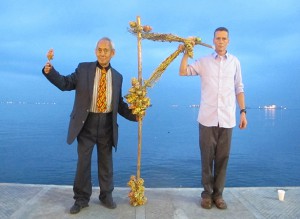Philippine Pavilion at the Venice Biennale
David Medalla
Performance: August 20, 2015, 3pm
With collateral events at the Sala dei Giardini (August 18, 2015) and the Peggy Guggenheim Collection (August 22, 2015)
Palazzo Mora
Strada Nuova 3659
Venice
Italy
The Philippine Pavilion, titled Tie A String Around the World, rests on an argument on worldmaking and the formation of empires. From the vantage of Genghis Khan, the first film ever made on the conqueror, the Pavilion lays out its premise while placing it within an exceptional lineage. Done in 1950 in Manila, the film was directed by Manuel Conde and co-written and designed by Carlos Francisco; edited and screened in 1952 at the Venice Film Festival and the Museum of Modern Art, it was annotated by writer and critic James Agee, translated into 16 languages and circulated worldwide. The film is key to the proposition of the Pavilion, affording it a long arc from early modernity to a contemporary global time in which the Philippines is in the midst of a dispute over parts of the South China Sea, of which China is claiming 80%. Around the film, the installation of Jose Tence Ruiz and the multi-channel video of Manny Montelibano generate discourses on this current predicament, as well as on the various contexts that have shaped Philippine historical life: cosmology, colonialism, and contemporary conquest, all of which gather to form both bricolage and baroque.
To further inflect the argument of the Pavilion on the saga of empires and the resistance against them, the Philippine artist and worldmaker David Medalla will perform at the Philippine Pavilion. Medalla was a seminal contemporary artist in the Philippines, initiating a significant break from Western modernism and internationalism in Manila in the ’50s. He organized poetry readings and performances and held his first exhibition of visual art at the artist-initiated space La Cave D’Angely in 1957. In 1960, he sailed for Europe. In London, he co-founded the Centre for Advanced Creative Study (which later became Signals London). There, he was involved in exhibitions that paved the path for much of what we know as contemporary art today: White on White in 1966; Air Art in 1968; Earth Art and Live in Your Head: When Attitudes Become Form in 1969. His engagements with the influential curator Harald Szeemann, specifically in When Attitudes Become Form and later in Documenta 5 in 1972, attested to Medalla’s importance as an artist in the then-emerging global contemporary art scene. Although working outside his native country, Medalla prospected a lively kind of Philippine subjectivity, suspicious of structures and notions of identity, and innovative in approaches to art making through performative and relational provocations. He was committed to process, railed against stasis, and was an activist. He was an indispensable figure in the prehistory of the contemporary, one who, with a ludic sensibility and broad sympathies, mediated the local and the modern in all their complications and did not merely supplement the internationalist style. In his words: “Everything must move, for movement is the only proof of life. It is the artist’s duty to bring life to inanimate objects.”
Medalla’s performance at the Philippine Pavilion is based on “telekinethetic dreams.” He revisits his previous sorties in Venice: In 1964, for instance, his sand sculpture was set up at the Villa Foscari in a nocturnal exhibition. Figuring in one of these dreams is the intriguing legend of the pirate Li Ma Hong, “who fled China at the end of the Ming Dynasty and came to the Philippines.” In Medalla’s words, Li Ma Hong was a kind of “hero (or more accurately an anti-hero)” of his boyhood. Titled Pangarap sa Panglao (Dream in Panglao), the performance likewise alludes to the T’ang Dynasty artist Wu Tao-tzu, the 20th-century writer Lu Hsun, and the explorer-scholar Antonio Pigafetta of Vicenza, whose chronicle of the voyage of Ferdinand Magellan inspired the idea of space-time relativity.
With the performance of David Medalla, in collaboration with Adam Nankervis, and a conversation with the curator Patrick Flores, the Philippine Pavilion speculates on the political future of artistic and political life in the world through the history of the sea and the flaneuries that map archipelagoes.
Image: Mondrian Fan Club, The Letter “P” on Manila Bay, 2013. Photo: Ramon Lerma. Courtesy Philippine Pavilion.


